

(4) Historiography. Bibliography. Origins of slavery. Cotton, Slavery, & the Old South. Interpretations of Slavery: Fogel and Engerman. Interpretations of Slavery: Eugene Genovese. Interpretations of Slavery: Phillips and Stampp. Kenneth M. Stampp, Obituary. Robert Evans (MIT) (3) Abolitionism. Just one of many Reform Movements. Reform Movements in 19th Century America America's greatest mental health reformer I.
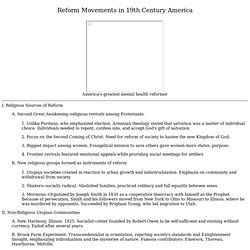
Religious Sources of Reform A. Second Great Awakening--religious revivals among Protestants. 1. Unlike Puritans, who emphasized election, Arminian theology stated that salvation was a matter of individual choice. 2. 3. 4. B. 2. 3. II. 1831, a monumental year in US history. VID: A grassroots movement. 1847 - North Star. June 2, 1848 issue North Star was a nineteenth-century anti-slavery newspaper published in the United States by abolitionist Frederick Douglass published until June 1851.
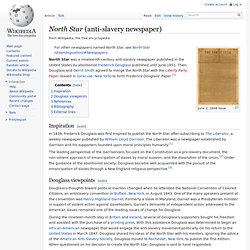
Then, Douglass and Gerrit Smith agreed to merge the North Star with the Liberty Party Paper (based in Syracuse, New York) to form Frederick Douglass' Paper.[1] 1831 - The Liberator. Liberator v.1, no.1, 1831 The Liberator (1831-1865) was an abolitionist newspaper founded by William Lloyd Garrison in 1831.
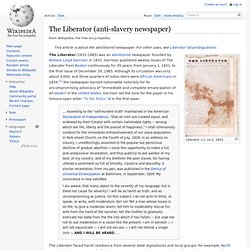
Garrison published weekly issues of The Liberator from Boston continuously for 35 years, from January 1, 1831, to the final issue of December 29, 1865. Although its circulation was only about 3,000, and three-quarters of subscribers were African Americans in 1834,[1] the newspaper earned nationwide notoriety for its uncompromising advocacy of "immediate and complete emancipation of all slaves" in the United States. VID: Literature (Uncle Tom's Cabin)
Abolition vs. Gradual Emancipation. American slavery was widely criticized from the very beginning, and many of the nation’s founders hoped, perhaps naively, that the Peculiar Institution would soon die a natural death.
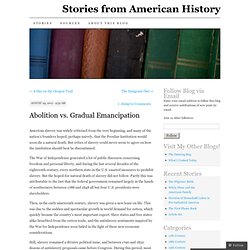
But critics of slavery could never seem to agree on how the institution should best be discontinued. The War of Independence generated a lot of public discourse concerning freedom and personal liberty, and during the last several decades of the eighteenth century, every northern state in the U.S. enacted measures to prohibit slavery. But the hoped-for natural death of slavery did not follow. Partly this was attributable to the fact that the federal government remained largely in the hands of southerners; between 1788 and 1848 all but four U.S. presidents were slaveholders. Compensated emancipation in DC. So it went in Washington in the spring of 1862.
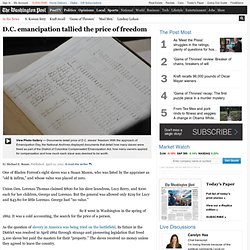
It was a cold accounting, the search for the price of a person. As the question of slavery in America was being tried on the battlefield, its future in the District was resolved in April 1862 through strange and pioneering legislation that freed 3,100 slaves but paid the masters for their “property.” The slaves received no money unless they agreed to leave the country. The District of Columbia Compensated Emancipation Act became law on April 16 — 150 years ago Monday. It was the cause of jubilation among those whose chains it broke, and today it is celebrated in Washington on “Emancipation Day," a city holiday.
On Wednesday, the National Archives displayed some records that detailed how many slaves were freed, how many owners applied for compensation and how much each slave was deemed to be worth. VID: Origins of the Abolition movement. Abolitionists Timeline of Important Dates. Feb 18, 1688 Mennonites Oppose Slavery The Mennonites of Germantown, Pennsylvania hold their monthly meeting and draft a set of resolutions in opposition to slavery, which they call "the traffic of men-body.

" Sewall Condemns Slavery. Miscellaneous abolitionists. Influence of religion. Divisions within Society. Immediatism From the 1829 publication of David Walker's Appeal onward, the antislavery movement shifted into a more radical phase as some abolitionists demanded immediate emancipation of all slaves rather than merely gradual steps toward future emancipation in the South and free soil in the new western territories.

William Lloyd Garrison sounded the clarion call with his 1831 launch of The Liberator, an antislavery newspaper based out of Boston. Garrison pledged to continue publishing The Liberator until the day that all American slaves were free. He kept his word, but as it turned out, that took 35 years. Garrison had grown up in an impoverished family in Newburyport, Massachusetts, and went on to become a newspaperman's apprentice and then an editor. A Southern Scapegoat Thomas Jefferson, James Madison, Patrick Henry, John Laurens, Arthur Lee, George Mason, and St.
Such relatively liberal positions would have been impossible to embrace for any major southern political leader by 1835. Influence of Race. VID: Black abolitionists. 1831 - 1st Negro convention movement. It started with a question.
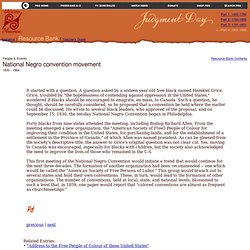
A question asked by a sixteen-year-old free black named Hezekiel Grice. Grice, troubled by "the hopelessness of contending against oppression in the United States," wondered if blacks should be encouraged to emigrate, en mass, to Canada. Such a question, he thought, should be carefully considered, so he proposed that a convention be held where the matter could be discussed. Negro Conventions. From the Emergence of the Cotton Kingdom to the Eve of the Compromise of 1850Philip S.
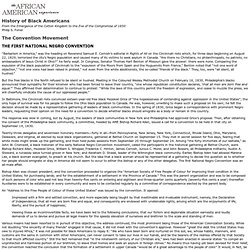
Foner. VID: Importance of Frederick Douglass. Call For Revolt. 1829 - Walker's Appeal. Political context. Antebellum era politics consisted of a series of failed compromises and increasingly acrimonious conflicts over slavery and the subject of abolition.
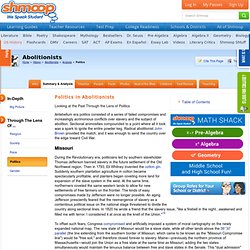
Sectional animosities compounded to a point where all it took was a spark to ignite the entire powder keg. Radical abolitionist John Brown provided the match, and it was enough to send the country over the edge toward Civil War. Missouri During the Revolutionary era, politicians led by southern slaveholder Thomas Jefferson banned slavery in the future settlement of the Old Northwest region. Then in 1793, Eli Whitney invented the cotton gin. To offset such fears, Congress compromised and artificially imposed a system of moral cartography on the newly expanded national map. Kentucky representative Henry Clay had to facilitate a second and less artful compromise at the last minute: Missouri's state constitution included a proviso that excluded free blacks and mulattoes from the state.
Petitioning. VID: John Brown. Influence of gender. Female Abolitionists cum Suffragists The abolitionist movement was pivotal for women, many of whom gained valuable experience with activism, organization, and a passionate commitment to ideals through their work fighting slavery. Female abolitionists got involved with politics, even if they still could not vote or hold office. They used their experience and their newfound voice to found their own movement for civil and political rights as American citizens. The women's suffrage movement and abolitionism were closely intertwined at their origins. Feminist leader Susan B. VID: Harriet Tubman. Anti-Slavery Movement: Women. PBS The Abolitionists - outline [ American Anti-Slavery Society. The Liberty Bell. Boston: American Anti-Slavery Society, 1856.
Division of Rare & Manuscript Collections. Carl A. American Colonization Society. The American Colonization Society (ACS; in full, "The Society for the Colonization of Free People of Color of America"), established in 1817 by Robert Finley of New Jersey, was the primary vehicle to support the return of free African Americans to what was considered greater freedom in Africa. It helped to found the colony of Liberia in 1821–22 as a place for freedmen. Among its supporters were Charles Fenton Mercer, Henry Clay, John Randolph, and Richard Bland Lee.[1][2][3][4] 1821 - Liberia Founded. Free Soil Party. The party membership was largely absorbed by the Republican Party in 1854. Positions[edit] In this 1850 political cartoon, the artist attacks abolitionist, Free Soil, and other sectionalist interests of 1850 as dangers to the Union. Free Soil candidates ran on the platform that declared: "...we inscribe on our banner, 'Free Soil, Free Speech, Free Labor and Free Men,' and under it we will fight on and fight ever, until a triumphant victory shall reward our exertions.
" The party also called for a homestead act and a tariff for revenue only. The Free Soil Party's main support came from areas of upstate New York, western Massachusetts, and Ohio, although other northern states also had representatives. History[edit] Van Buren / Adams campaign banner 1848 cartoon for Van Buren.
Liberty Party. The Liberty Party was a minor political party in the United States in the 1840s (with some offshoots surviving into the 1850s and 1860s). The party was an early advocate of the abolitionist cause. It broke away from the American Anti-Slavery Society (AASS) to advocate the view that the Constitution was an anti-slavery document; William Lloyd Garrison, leader of the AASS, held the contrary view that the Constitution should be condemned as an evil pro-slavery document. The party included abolitionists who were willing to work within electoral politics to try to influence people to support their goals; the radical Garrison, by contrast, opposed voting and working within the system.
The party was announced in November 1839, and first gathered in Warsaw, New York. Its first national convention took place in Arcade on April 1, 1840. VID: Factors encouraging anti-slavery movement (and why ACW broke out when it did) Abolitionism. Abolitionism is a movement to end slavery, whether formal or informal. In Western European and America, abolitionism was a historical movement to end the African and Indian slave trade and set slaves free. US Slave Free 1789-1861. 1777 - Vermont Abolishes Slavery. 1787 - Northwest Ordinances. 1807 - Slave Importation Banned. 1820 - Missouri Compromise.